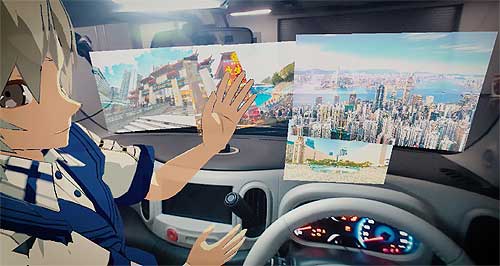News - NissanCES: Nissan revamps vehicle user interface with I2VVirtual avatars, augmented reality, holographic mapping feature in Nissan’s I2V tech4 Jan 2019 By TUNG NGUYEN NISSAN will unveil new technology at the Consumer Electronics Show (CES) in Las Vegas next week dubbed Invisible-to-Visible (I2V) that aims to bridge the virtual and physical driving worlds with simulated assistants, holographic maps and augmented windscreens.
Designed as part of Nissan’s Intelligent Mobility initiative, the I2V technology uses both live-feed exterior sensors and infrastructure data pulled from the cloud, which can then be presented to vehicle occupants in various ways.
According to Nissan, the concept was developed “from research into how user interface and user experience of cars will evolve as autonomous driving and connectivity continue to advance”.
Nissan Research Centre expert leader Tetsuro Ueda explained that when the vehicle “processes sensing data and visualises it, the driver feels at ease and can trust the car, resulting in a more confident and comfortable drive”.
“In the future, visualisation will remain key for the user interface and user experience,” he said.
In a video introducing the technology, the exterior sensor data is represented by a holographic map which shows buildings and obstacles that cannot be seen by the naked eye, as well as hidden hazards that might not be anticipated by the driver.
With this data, Nissan’s I2V technology is able to warn drivers of pedestrians crossing the road or where a parking spot has become available.
The vehicle’s interior sensors will also be used to monitor driver behaviour and suggest driving breaks when it detects fatigue.
Combining the sensor data with infrastructure data stored on the cloud will also allow the I2V system to plan better driving routes to avoid traffic congestion, while Nissan also showcased its augmented reality potential by ‘clearing’ a foggy road by projecting an image of the same road on a sunny day on the windscreen.
For those so inclined, the windscreen can also show the racing line while a virtual coach can also be summoned to improve driving techniques.
In addition to the driving coach, other avatars can be beckoned to help with navigation and other activities, as well as what could be projections of actual people.
“Cars will be autonomous, giving drivers more time for human interaction,” Mr Ueda said. “Your driving companion can be anyone, even if they cannot physically be with you in the car because they can appear as avatars.”
He also said “the cars of the future will create totally new interactive experiences”, while Nissan believes its new I2V technology “opens up endless possibilities for service and communication”.
 Read more12th of January 2018  CES: Society not ready for full autonomy: NissanNissan points to social, regulatory hurdles blocking fully self-driving cars11th of January 2018  CES: Nissan B2V tech expected to make productionControlling cars with brainpower part of Nissan’s ‘Intelligent Mobility’ strategy |
Click to shareNissan articlesResearch Nissan Motor industry news |
















Facebook Twitter Instagram